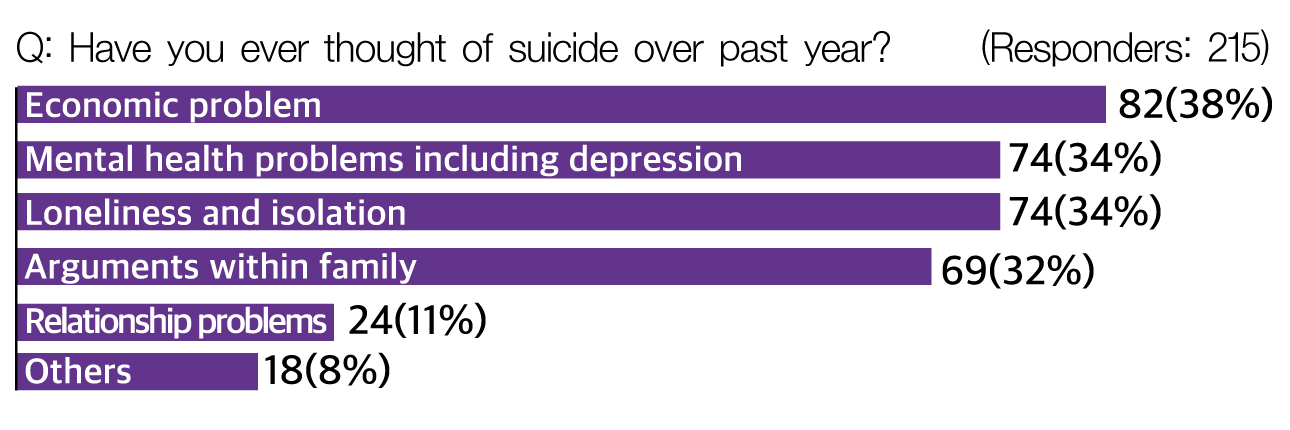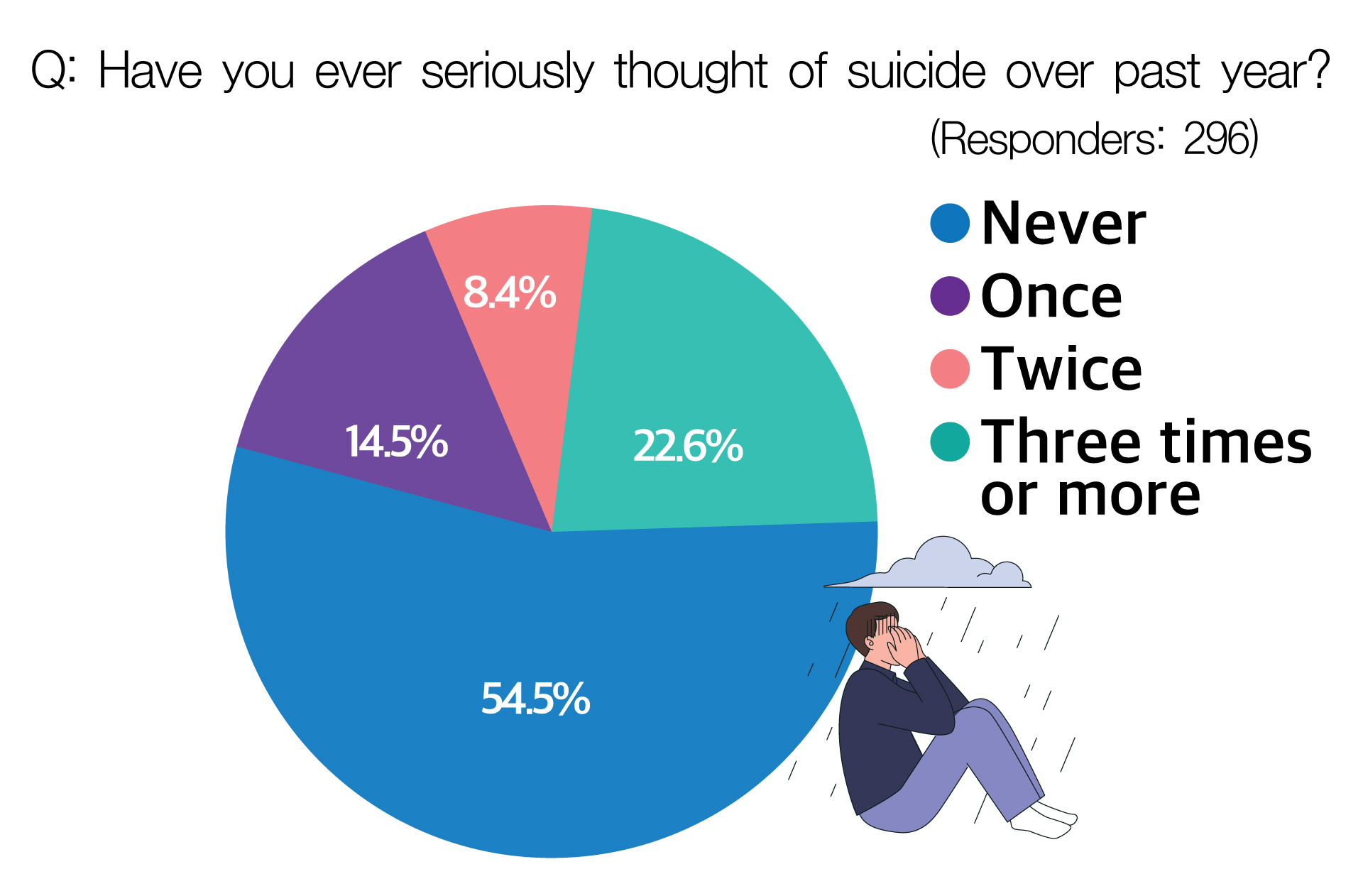[The Korea Daily-USC] Healing California Project
The Korea Daily analyzed Korean suicide rates from 2011 to 2022, using data from the Los Angeles County Department of Mental Health (LACDMH), the California Department of Public Health (CDPH), and national suicide statistics from the Centers for Disease Control and Prevention (CDC).
The suicide rate among Koreans rose sharply from 10.3 per 100,000 population in 2011 to 15.7 in 2022. In 2018, the rate peaked at 16.0. It then decreased to 11.9 in 2020 during the pandemic but surged again to 15.7 in 2022. During the same period, the overall U.S. suicide rate increased from 12.3 in 2011 to 14.4 in 2022.
According to the CDC’s Provisional Suicide Deaths in the United States, 2022, there were nearly 50,000 suicides in the U.S. in 2022, the highest number on record. Furthermore, 1 in 21 U.S. adults ages 18 and older had seriously contemplated suicide in 2021, with one in 71 making a specific plan, including a method of suicide. These figures are significantly lower than those reported by the Korea Daily and the Korean suicide rate.
The Federal Census Bureau estimates the Korean population in the U.S. as of 2022 to be 1.51587 million (2.05172 million when including all Koreans).
Urgent Need for Korean Suicide Prevention in California
In California, particularly, there’s a critical need for suicide prevention measures within the Korean community.
In LA County, home to about 230,000 Koreans, 29 Koreans committed suicide in 2022 (according to CDC statistics). That year, the suicide rate for Koreans in LA County was 12.3 per 100,000 population, nearly double the rate of 6.3 for all Asians.
CDC statistics reveal that between 2018 and December 24, 2023, 1,036 Koreans committed suicide in the United States, with 348 (30%) in California alone.
During this period, the average suicide rate for Asians in California was 6.5 per 100,000 population. However, the rate for Koreans ranged from 11.5 to 14.3, higher than the rate for all California residents (10.4 to 11.3) and double the rate for Asians.
Cultural and Environmental Factors
Why is the Korean suicide rate so high in the United States?
Mental health professionals working with Korean suicides identify culture and environment as key factors.
Most Korean suicides share a common background: they are first- and 1.5-generation immigrants born in Korea, according to health authorities like the LACDMH.
Dr. Justin Choe, Ph.D., a former president of the Korean American Psychological Association in California, stated, “Suicide rates in the Korean American community have long mirrored those in South Korea. The cultural and spiritual connections are uniquely strong, even across the Pacific Ocean.”
Today, South Korea has been working for 20 years to overcome its reputation as the world’s leading country for suicides. In 2021, the suicide rate was 23.6 per 100,000 people, more than double the OECD average of 11.1.
Mental health professionals have identified several aspects of Korean culture contributing to the country’s high suicide rate. These include a strong emphasis on achievement and intense competition; fear of financial instability; a focus on preserving social reputation; prejudices against mental health issues like depression and inadequate stress management strategies; as well as burnout. The ‘Hwabyeong’ phenomenon, a condition where individuals struggle to express grievances or anger, leading them to endure suffering silently, is also prevalent among Koreans.
In the Korea Daily’s ‘Korean Community Mental Health Survey,’ 38% of 215 respondents (82 individuals) cited economic problems as the primary reason for their suicidal thoughts (allowing for multiple choices). This was followed by mental health issues such as depression (34%), loneliness and isolation (34%), family disputes (32%), and relationship problems (11%). Other reasons included poor health, loss of life’s meaning, workplace discrimination, and aging.
“Due to the country’s rapid economic growth, Koreans and Korean Americans highly value competition and achievement. They also maintain a strong culture of face-saving to avoid public embarrassment. When these cultural traits coincide during a personal crisis, it creates a dangerous emotional cocktail,” explained Jae Won Kim, Mental Health Training Coordinator at the LACDMH.
“Koreans have a long tradition of enduring suffering in silence, a culture that values virtuosity. This is partly due to ‘Hwabyeong,’ a syndrome that often prevents people from seeking help when they are mentally distressed.”
The Crisis of Suffering Alone
In a related survey, when asked why they did not share their suicidal thoughts, 52% of 209 respondents said they preferred to deal with it alone. This was followed by reasons such as embarrassment (25%), feeling it was a bother to others (13%), and not knowing how to express it (10%).
Dr. Choi, a clinical psychologist, commented, “Koreans often feel ‘weak’ or ‘ashamed’ to contemplate suicide or seek treatment for mental illnesses like depression. The societal pressure to care about others’ opinions can lead to suicide, as it slowly destroys individuals’ self-esteem and will to live.
The environmental factors of an immigrant society, such as high interest in Korean affairs, the closed nature of the immigrant community, loneliness and isolation, a lack of shared values, and intergenerational misunderstandings, also contribute to the high rate of suicide among Koreans.
“Failures in business, family disputes, and difficulties in forming relationships can lead to a loss of life’s meaning. People end up committing suicide out of despair and fear of a bleak future,” Dr. Choi added, noting, “When someone expresses their struggles, the common reaction is to leave them alone to save face. However, this only increases the pain of depression and isolation.”
“Korean cultural values concerning mental health and suicide are deeply ingrained in the Korean community across borders and generations,” said Grace Park, Clinic Services Manager at the Koreatown Youth and Community Center (KYCC). “Especially, Korean culture places immense pressure on individuals to succeed and climb the social ladder. This pressure is passed from parents in Korea to their children in the U.S.”
BY HYOUNGJAE KIM, JUNHAN PARK [kim.ian@koreadaily.com]







